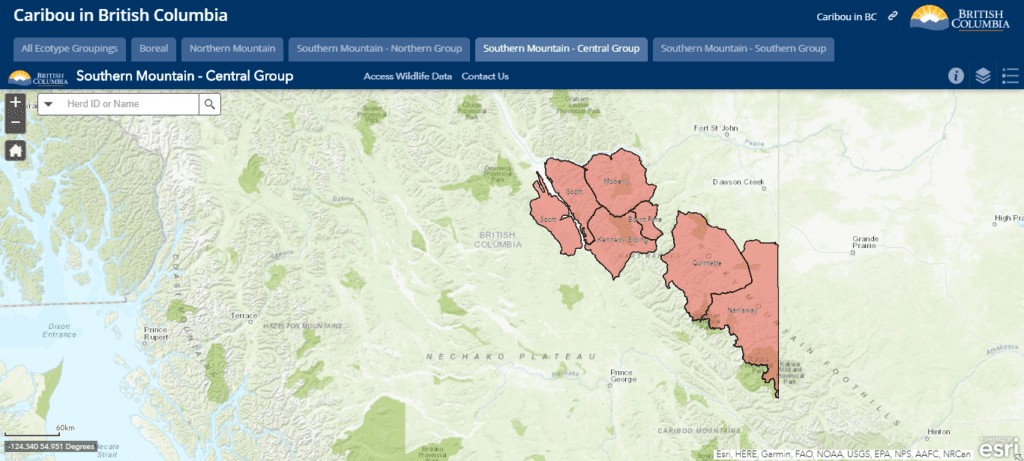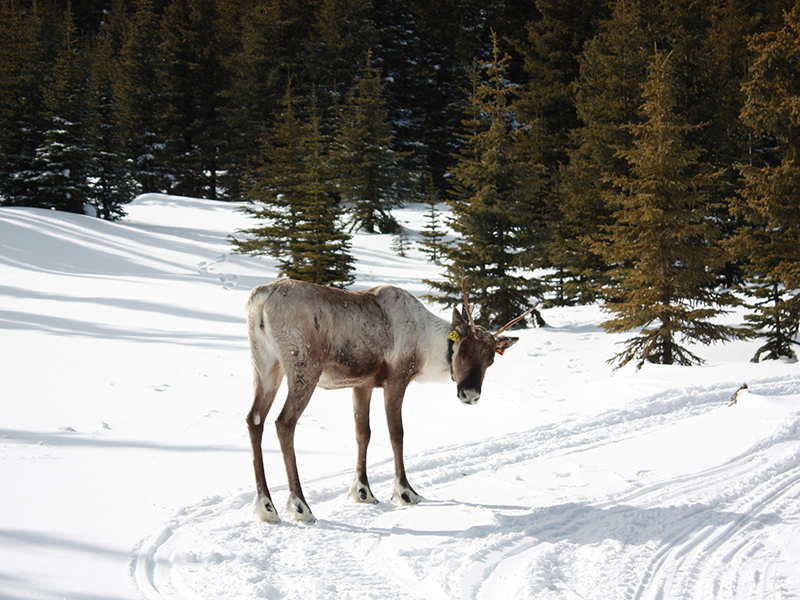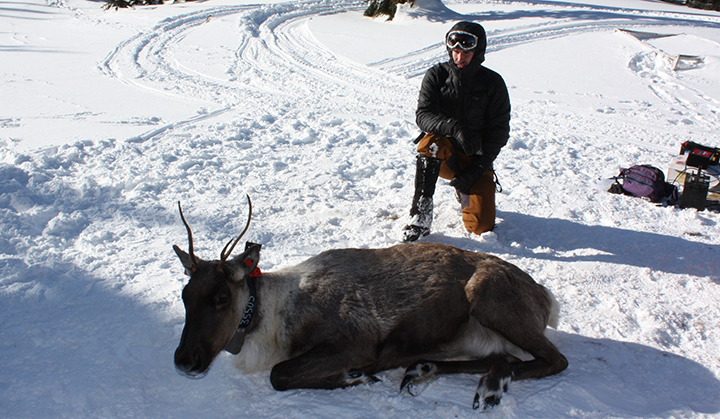Liber Ero post-doctoral fellow Dr. Clayton Lamb works with Indigenous, academic, non-profit and government partners to recover mountain caribou on the brink of extirpation in the Peace region
From tiny pika to giant grizzly bears, wide-ranging wolverine and now endangered mountain caribou, Dr. Clayton Lamb’s conservation career has taken him across some of the wildest parts of the Yellowstone to Yukon region.
And now, Clayton has received a two-year Liber Ero post-doctoral fellowship to work on the recovery of the Central Group of southern mountain caribou in British Columbia’s Peace Region (“the Peace”). Y2Y is collaborating as a conservation mentor on this research and in applying its findings.
Clayton’s work is timely given the landmark partnership agreement signed in February 2020 among West Moberly and Saulteau First Nations, British Columbia and Canada to improve protection across approximately 8,000 square-kilometers (3,089 square-miles) of caribou habitat.
The goal of Clayton’s work is to address research questions such as: how do we most effectively recover the disturbed areas in the Peace? And: how can a range of potential management actions provide the greatest possible benefit to caribou?
Developing a career in conservation science
We love speaking with scientists about their research because there’s often a specific driving force behind their work — a memory or story of how experiences in wild places or with wildlife led them along their career path.
When we caught up with Clayton, he explained how hunting and fishing in western British Columbia, where he grew up, sparked a natural curiosity about how (and where) wildlife lives and moves.
“I wanted to play an active role in looking after the landscapes that had always been a source of inspiration and connection for me.”
Dr. Clayton Lamb, Liber Ero post-doctoral fellow
“Through the years, I started to wonder more about what drives the density of wild animals, how human influence plays a role, and the challenges that wildlife faces in busy environments,” says Clayton. “I wanted to play an active role in looking after the landscapes that had always been a source of inspiration and connection for me.”
Collaborating for caribou conservation
During his Liber Ero fellowship, Clayton will study changes in caribou populations and habitat recovery options in the Peace. He will work closely with West Moberly First Nations and Saulteau First Nations, Wildlife Infometrics, Y2Y, and the B.C. government. The team will now focus efforts on the five remaining herds in B.C.’s endangered Central Mountain caribou group.

Caribou conservation and recovery is complicated. It brings together legal, ecological and human rights issues. Like other wildlife in the Yellowstone to Yukon region, healthy caribou populations are integral to healthy, whole ecosystems in the Peace. Caribou have also long been immensely important to First Nations.
However, caribou have severely declined in the Peace over the last century, which stands to extinguish the knowledge and practice of hunting caribou: a violation of legal treaty rights that threatens long-standing cultural connections. The root cause of caribou decline and disappearance across most of B.C. and Canada is loss of habitat due to human activity such as logging, dams and roads.

Yet, there is a good news story here, too. One of the few examples of caribou numbers increasing in North America can be found in the Peace, where Indigenous-led conservation efforts have brought the Klinse-Za herd from 36 animals in 2013 to more than 80 today.
The research that Clayton and his partners are doing will test the efficacy of implementing a range of management measures to recover caribou populations and restore caribou habitat, including those in the partnership agreement.
“We’re going to integrate scientific and local stewardship methods to ‘reimagine’ the future of caribou and habitat recovery in the Peace. That includes habitat and population modeling to come up with a range of management scenarios that would lead to successful recovery,” says Clayton.
“Increasing caribou populations to a point that would sustain culturally-meaningful hunting by the First Nations would be a victory for both reconciliation and conservation.”
Aligning with Y2Y’s work
The Peace region has been home to Indigenous peoples since time immemorial, and Treaty 8 First Nations are leaders in the conservation of the land and wildlife. Y2Y works in respectful partnership with Treaty 8 Nations in support of their communities’ conservation and environmental goals, explains Tim Burkhart, Y2Y’s program manager for strategic engagement and the Peace region.
“We support those goals through projects to map habitat, understand cumulative impacts of industry on wildlife and treaty rights, reduce wildlife-vehicle collisions, and recover endangered species like mountain caribou,” says Tim.
Y2Y also plays an important role in organizing voices in support of caribou recovery and Indigenous-led conservation. This project’s approach, which would ideally be replicable elsewhere, is well-aligned with our work throughout the region.
“Since the Peace is the narrowest part of the whole Yellowstone to Yukon region, conservation has implications for people and nature to the north and south,” says Y2Y’s conservation scientist, Dr. Aerin Jacob. “Responsible management needs rigorous evidence – that’s why we’re glad to work with Clayton and this team.”
“Responsible management needs rigorous evidence – that’s why we’re glad to work with Clayton and this team.”
Dr. Aerin Jacob, Y2Y conservation scientist
Clayton’s varied field experience in coexistence and conservation science not only crosses paths with Y2Y‘s mission, but will also lend itself well to the project. He has studied climate sensitivity of the American pika in Oregon’s mountains, population ecology of grizzly bears, black bears, and wolverine across western Canada, and learned what it takes to turn scientific evidence into meaningful action on the ground.
Y2Y has also supported Clayton’s work to reduce carnivore attractants in southern B.C. and continues to collaborate with him and other partners on ways to make Highway 3 safer for wildlife and people in B.C.’s Elk Valley.
However, a highlight of his work to-date has been learning about Indigenous-led conservation and how to best support Indigenous partners.
“There’s so much to learn from the leadership that the West Moberly and Saulteau First Nations have taken for mountain caribou, which is instrumental for this species’ recovery,” says Clayton. “Working together to apply different types of knowledge is a big part of my research, and I’m so happy to be a part of this work to help recover mountain caribou.”
More about the Liber Ero fellowship
The Liber Ero post-doctoral program seeks to support exceptional early-career scientists to conduct and communicate research that informs applied conservation and management issues relevant to Canada. For his post-doc research, Clayton will work with academic advisors Dr. Adam Ford at UBC-Okanagan and Dr. Mark Hebblewhite at the University of Montana, and with conservation mentors Dr. Aerin Jacob and Tim Burkhart at Y2Y, Dr. Scott McNay of Wildlife Infometrics, and the Nîkanêse Wah tzee Stewardship Society — an initiative between West Moberly First Nations and Saulteau First Nations that drives Indigenous-led conservation in the Peace.


